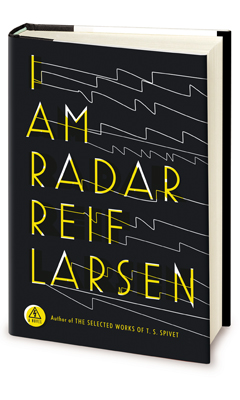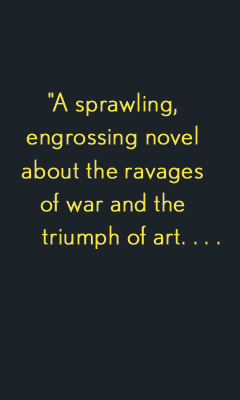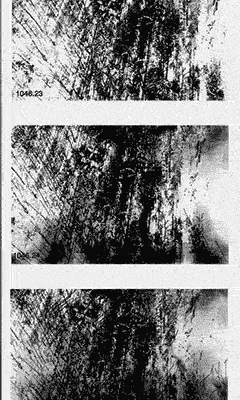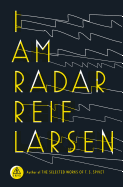I Am Radar
by Reif Larsen
In his second novel, author Reif Larsen (The Selected Works of T.S. Spivet) has woven heavy-hitting philosophical and emotional exploration into an international, intergenerational story of Homeric proportions. I Am Radar is a book about electricity. It's a book about families, and colonialism, and languages and war. It holds the epic, intricate delight of the best children's fantasy blended with an impressive intertextuality geared toward a well-read adult audience. Much of the novel's delight lies in the sprawling nature of its plot, which spans continents and generations over the course of its 600-plus pages. From New Jersey to Cambodia and throughout the 20th century, Larsen recounts the life stories of a series of people connected by a secret Norwegian organization formed during World War II and known as Kirkenesferda. It's a wild ride with an unconventional structure balanced by an enormous cast of compelling and unforgettable characters.
Part 1 of the novel begins, as do many great stories, with a birth. In this case, a white couple living in New Jersey gives birth to a black son. Not just a boy darker than his parents, but a child with skin and hair black as night, from head to toe. This miraculous baby is Radar--so christened by his father, Kermin, an electrical engineer and immigrant from war-torn Bosnia. Despite the doctors' repeated assurances that her son is fine, Radar's condition sends his mother, Charlene, spiraling into obsession. While she's busy in her single-minded search for a diagnosis, Larsen takes us back through her eventful life, which involves heroin, Anna Karenina, arson, the Dewey decimal system and the excellent phrase "astrological strip Ouija." When Larsen returns to the present day of Radar's birth, the effect is one of sudden depth: the dull, neurotic mother is revealed as an ex-addict and '70s wild child searching for order in a painfully chaotic world.
As Charlene searches feverishly for answers, Kermin becomes more and more convinced that nothing is wrong with their son. Taciturn and stoic, Kermin is as loving as he is eccentric. It comes as no surprise, then, that when a mysterious letter arrives from Norway offering a possible "cure" for Radar's condition, Kermin flatly refuses to consider it. Charlene insists on responding, and soon the family finds themselves on an all-expenses-paid trip to the Arctic Circle, where the members of Kirkenesferda await them. There, in a land north of everything, an odd man spins them a tale of art and philosophy. Kirkenesferda is interested in using electricity to blur the line between performer and puppet in large-scale metaphysical stagecraft. Despite Kermin's hesitance, the mad scientists charm both parents and they allow Radar to undergo a procedure intended to change his skin color.
Part 2 of the novel takes place far from 21st-century New Jersey, in 1975 Bosnia. There, we are introduced to a three-year-old named Miroslav who has just swallowed a key. That young boy and his brother grow up to play very different roles in the civil war that tears their country to pieces. One is destined to become an infamous Chechen fighter, while the other becomes a guerrilla puppeteer and cult artistic figure in Sarajevo. Engrossing in and of itself, their tale offers bits and pieces of background that explain the origins of Kirkenesferda and the organization's connection to Radar's family.
Later, Larsen takes the reader south to Cambodia in 1953, where another miraculous birth is about to take place. On a rubber plantation owned by an French scientist, a tiny baby found floating in a river becomes the subject of an experiment in scientific child-rearing. His story involves sign language, the history of x-rays, the Khmer Rouge and, eventually, a tragic involvement with Kirkenesferda's ill-fated final performance.
These historical digressions alternate with the continuing saga of Radar's life. A decade or so after undergoing the experimental procedure in Norway, Radar is pale, prematurely balding and epileptic. He spends his days writing down his own "rules for life" in a notebook, working as a radio engineer and nursing a crush on the cute girl at the convenience store. All that changes one day when his father disappears during a freak blackout that destroys every electrical device in New Jersey. Radar finds himself on a high-stakes trans-Atlantic scavenger hunt that eventually leads him to discover the truth about his past and take his place in the final Kirkenesferda production.
Larsen's prose is straightforward and bold, full of sparkling phrases that wink out from the constantly evolving action; the diagrams and illustrations that appear throughout add to the sense of intricate world-building. Each character and subplot is treated with the same joyful, meticulous focus, making it easy to get lost in Charlene's, Kermin's or Miroslav's lives and forget the larger arc of the story. This makes the novel a joy to re-visit, as hidden treasures and connections appear with each re-reading. Wise yet unpretentious, both broad and deep, I Am Radar will slake the most unquenchable thirst for storytelling and open the reader's eyes to new possibilities in fiction. --Emma Page








 Reif Larsen's first novel, The Selected Works of T.S. Spivet, was a New York Times bestseller and is published in 29 countries. The novel was a 2010 Montana Honor book, a Border's Original Voices Finalist, an IndieBound Award Finalist and was shortlisted for the Guardian First Book award and the James Tait Black Memorial Prize. It was also adapted for the screen in 2013 by Jean-Pierre Jeunet (Amélie). Larsen's essays and fiction have appeared in the New York Times, the Guardian, Tin House, one story, the Millions and the Believer. His new novel, I Am Radar, will be published February 24, 2015, by Penguin Press and is the subject of a documentary film about translation. Larsen is currently the writer-in-residence at the University of St Andrews in Scotland.
Reif Larsen's first novel, The Selected Works of T.S. Spivet, was a New York Times bestseller and is published in 29 countries. The novel was a 2010 Montana Honor book, a Border's Original Voices Finalist, an IndieBound Award Finalist and was shortlisted for the Guardian First Book award and the James Tait Black Memorial Prize. It was also adapted for the screen in 2013 by Jean-Pierre Jeunet (Amélie). Larsen's essays and fiction have appeared in the New York Times, the Guardian, Tin House, one story, the Millions and the Believer. His new novel, I Am Radar, will be published February 24, 2015, by Penguin Press and is the subject of a documentary film about translation. Larsen is currently the writer-in-residence at the University of St Andrews in Scotland.